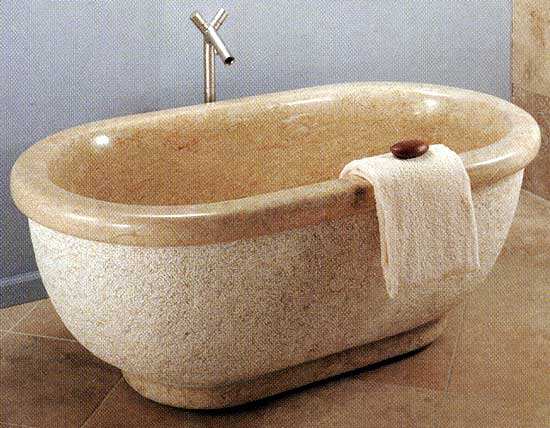Luxurious Aesthetics and Design Versatility of Stone Bathtubs
How Stone Enhances Visual Elegance in Modern Bathrooms
Stone bathtubs really step up the look of bathrooms thanks to those natural textures and rich colors that just can't be faked. Take marble and onyx for instance these materials have those unique vein patterns no plastic can copy. The way they feel under touch adds real depth to any space, which is why so many people love them for both modern minimal looks and nature-inspired designs. According to a recent survey from Bath & Kitchen Design News in 2024, about 8 out of 10 homeowners say they want authentic materials when redoing luxury bathrooms, making stone tubs the top choice by far. Stone has something special compared to acrylic or porcelain options too. Even in industrial style bathrooms where everything feels cold and metallic, stone still manages to bring warmth. It works surprisingly well alongside metal fixtures and wooden touches without looking out of place at all.
Custom Finishes, Shapes, and Freestanding Designs for Unique Spaces
Stone bathtubs come in well over fifteen standard shapes these days, everything from sharp edged modern looks to flowing organic forms. Most upscale bathroom projects actually end up getting customized somehow despite all those standard options. Freestanding tubs are really taking off in popularity, giving designers freedom to place them anywhere they want instead of just sticking them in corners where plumbing happens to be. The finishes available today are pretty amazing too. Some have that super shiny surface that catches light everywhere while others have a softer brushed look that hides water spots better. All this variety makes it possible to fit stone tubs into almost any space, whether it's a tiny city apartment bathroom or something grander like a full blown spa area with lots of room to spread out.
Trend: Stone Bathtubs as Centerpieces in High-End and Spa-Like Interiors
Top hotel chains and home design professionals have started putting stone bathtubs at the center of their spaces because they really make rooms feel bigger and more valuable somehow. One big name in luxury resorts saw guest happiness jump by nearly 27 percent when they swapped out regular tubs for stone ones in their top-tier suites. We're seeing this same interest in private homes too. When folks spend over $150k on bathroom renovations, almost half end up choosing those large 66 inch freestanding stone tubs that stand alone in the room. Interior designers love combining these statement pieces with lots of open space, big windows that go all the way down to the floor, and subtle lighting underneath cabinets or around mirrors to create that fancy spa vibe people want so badly nowadays.
Exceptional Durability and Long-Term Performance in Wet Environments
Inherent Strength of Natural and Engineered Stone Materials
Stone bathtubs derive their resilience from the geological properties of materials like granite, marble, or engineered quartz composites. Natural stone exhibits compressive strengths up to 20,000 psi, while modern engineered variants reinforce this durability with polymer resins—proven to withstand decades of use without structural degradation.
Resistance to Scratches, Stains, and Moisture Damage
Non-porous surfaces and advanced sealing technologies prevent water absorption (<0.5% per ASTM C97 standards), eliminating risks of mold or mineral deposits. Unlike acrylic or enamel-coated alternatives, stone maintains its integrity when exposed to harsh bathroom cleaners, cosmetics, or thermal shocks from hot water.
Case Study: Commercial Spas and Luxury Residences Relying on Stone Longevity
A 2023 hospitality industry analysis revealed 87% of premium spa operators prefer stone tubs for high-traffic wet areas due to their 25+ year service life. Notably, a Maldives resort reported zero maintenance costs on its 14 stone soaking tubs during their first 7 years of saltwater-heavy operation.
Superior Heat Retention for a Warmer, More Efficient Bathing Experience
Thermal Mass Properties of Stone vs. Acrylic and Cast Iron
Stone bathtubs take advantage of dense materials such as granite, marble, and engineered quartz which are really good at absorbing heat and then slowly releasing it back into the water. Acrylic tubs tend to lose their warmth pretty quickly after filling them up, sometimes cooling down in just about 15 to 20 minutes flat. Stone on the other hand keeps the water warm for roughly half the time longer because of its thermal properties. Cast iron might last longer than acrylic but still falls short compared to real stone when it comes to holding heat. The reason? Natural stone has this unique microcrystalline structure that actually traps heat molecules inside, something cast iron just doesn't have. That makes the heat escape much faster from cast iron tubs than from genuine stone ones.
Energy Efficiency Through Passive Heat Retention
Stone's ability to slowly release heat means we don't need to keep reheating water all the time, which saves energy somewhere around 18 to maybe even 25 percent when compared with regular materials out there. The way stone holds onto warmth fits right into green building practices too. Take a look at those stone tubs sitting in bathrooms across the country. They stay warm for well over an hour after being filled, sometimes close to ninety minutes straight without needing any extra heating. That makes them great for places where winters get cold or for bigger bathrooms where traditional systems would just burn through electricity trying to maintain temperature.
Strategy: Reducing Water Heating Cycles with Stone Bathtub Insulation
Enhancing a stone tub’s inherent thermal efficiency involves pairing it with insulating underlays or perimeter sealing to reduce ambient heat loss. For colder regions, integrating heated backrests or recessed floor heating beneath the tub creates a synergistic system that extends soak times without additional water heating cycles.
Eco-Friendly Material Choice and Sustainable Investment Value
Low Environmental Impact and Recyclability of Stone
Stone bathtubs make good use of the natural or man-made stone's built-in eco benefits since they need far less processing work compared to those made from plastics. When we look at materials such as granite and marble, these actually produce around 40 percent fewer carbon emissions when being mined out of the ground than what happens with making acrylic products. Plus, many engineered stones contain recycled quartz particles already mixed into them. Stone stands apart from other composites that can't be recycled at all because it is completely recyclable itself. Old stone tubs get broken down and reused either as part of building materials or even turned into brand new surfaces somewhere else. Research published in 2023 about choosing green materials showed stone comes out ahead in life cycle tests, especially where factories use lots of water during production processes.
Stone Bathtubs in LEED-Certified and Sustainable Building Projects
More architects these days are going for stone bathtubs when working on buildings aiming for LEED v4.1 certification. The reason? Materials made from recycled stuff or sourced locally can really boost those important credit points. Take this wellness center in Colorado that's running on net zero energy. They cut down their embodied carbon by about 28 percent just by installing limestone bathtubs from nearby quarries rather than bringing in cast iron from far away. Makes sense when we look at what the Global Green Building Council found out too. Natural stone seems to help reduce energy costs between 15 and maybe 22 percent in bathrooms where humidity is always high because it naturally resists mold growth without needing special treatments.
Long Lifespan Reduces Replacement Waste and Supports Circular Design
Stone bathtubs last over 50 years, which is three times longer than those acrylic ones we see everywhere these days. Because they don't need replacing so often, they cut down on all that junk ending up in landfills after bathroom makeovers. Some companies have started taking back old stone tubs too, turning them into something useful like kitchen countertops or bathroom tiles. The Circular Design Handbook actually mentions this as good practice for sustainability. And let's talk money for a second. These durable tubs save homeowners cash in the long run. A study came out in 2023 showing people who chose stone instead of fiberglass got about 62 percent better return on investment. Why? They don't have to replace their tubs every few years and they use less energy heating water because stone retains heat better than those cheaper materials.
Minimal Maintenance Requirements Without Compromising Luxury
Non-Porous Surfaces and Advanced Stain Resistance Technology
Stone bathtubs really cut down on all that constant cleaning because they have these super dense surfaces that don't absorb anything. Regular materials such as wood or old school ceramic tend to trap bacteria and let soap scum build up over time. But not so much with stone. According to research from the Bath Material Study released in 2024, people who installed these fancy stone tubs spent about two thirds less time scrubbing than those with acrylic ones. Plus, newer versions made from engineered quartz and sintered stone actually come with special coatings at the microscopic level that push away oil and minerals before they can stick around. Makes sense why so many homeowners are making the switch these days.
Easy Cleaning for Busy Households Seeking Lasting Elegance
Keeping these tubs clean is surprisingly simple really just grab a soft cloth and some pH neutral cleaner. No need for those rough scrub brushes or fancy polish stuff that costs an arm and a leg. The material itself fights off etching and color changes so even the busiest people can keep their bathroom looking good without breaking a sweat. Stone bathtubs stand out because they work well for families who want something beautiful but also practical. Most everyday messes from spilled water or skincare products just wipe right off, no residue left behind and definitely no need for strong chemical cleaners that might damage surfaces over time.
FAQ
Are stone bathtubs more expensive compared to other materials?
Yes, stone bathtubs are generally more expensive upfront compared to materials like acrylic or fiberglass, but they offer longevity, durability, and ecological benefits that justify the investment over time.
Do stone bathtubs require special cleaning products?
No, stone bathtubs can be cleaned with simple pH neutral cleaners and a soft cloth. Avoid harsh chemicals as they aren't necessary and could damage the finish.
Can you install a stone bathtub in any bathroom size?
Stone bathtubs come in a variety of shapes and sizes, allowing them to fit most bathroom layouts, whether small apartments or larger spa-like spaces.
Table of Contents
- Luxurious Aesthetics and Design Versatility of Stone Bathtubs
- Exceptional Durability and Long-Term Performance in Wet Environments
- Superior Heat Retention for a Warmer, More Efficient Bathing Experience
- Eco-Friendly Material Choice and Sustainable Investment Value
- Minimal Maintenance Requirements Without Compromising Luxury

